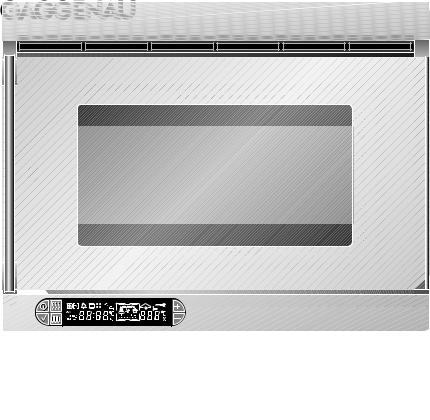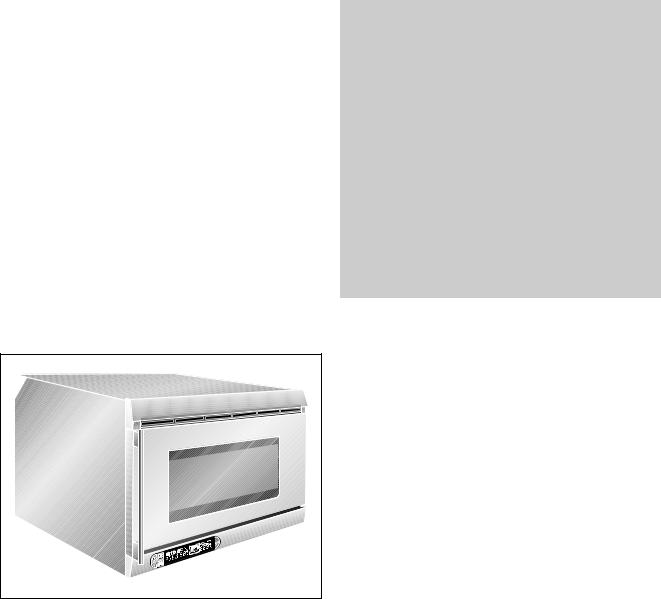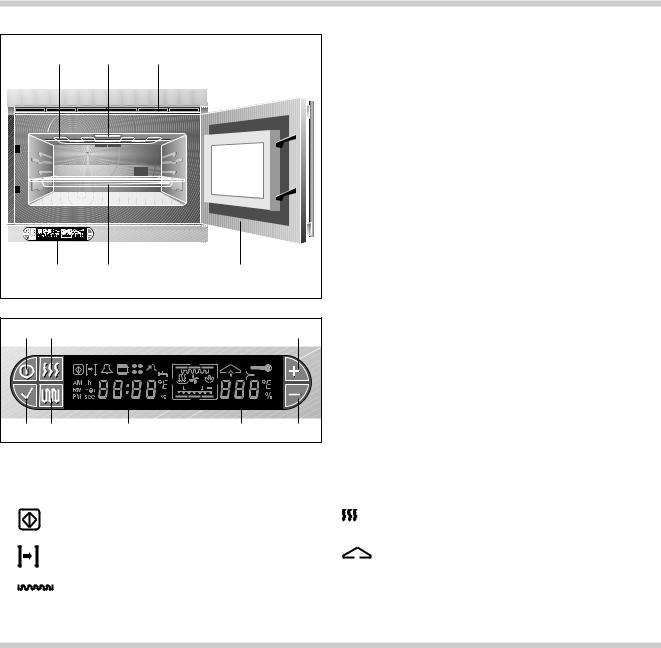Gaggenau EM221130, EM220130, EM220110, EM221110 Manual

Operating and assembly instructions
EM 220/221
Built-in microwave oven with grill
EM 220/221
1. |
Important Notes |
Page 3-5 |
||
|
|
Operating for the first time |
Page 3 |
|
|
|
About use |
Page 3 |
|
|
|
General safety information |
Page 4 |
|
|
|
Safety information concerning microwave operation Page 5 |
||
|
2. |
Features and operating principles |
Page 6-9 |
|
|
|
Features |
Page 6 |
|
|
|
Cooking methods |
Page 7 |
|
|
|
What you should know about utensils |
Page 8 |
|
|
|
Cookware overview table |
Page 9 |
|
|
|
|
|
|
|
3. |
Operation |
Page 10-12 |
|
|
|
Microwave oven |
Page 10 |
|
|
|
Grilling |
Page 11 |
|
|
|
Combined operation |
Page 12 |
|
4. |
Further functions |
Page 13-16 |
||
|
|
3-stage programming |
Page 13-14 |
|
|
|
Options menu, setting the clock |
Page 15 |
|
|
|
Child lock |
Page 15 |
|
|
5. |
Practical tips |
Page 17 |
|
|
|
|
|
|
|
6. Cleaning and care |
Page 18 |
||
|
7. |
Troubleshooting |
Page 19 |
|
|
8. Maintenance |
Page 20-21 |
|
|
|
|
General |
Page 20 |
|
|
|
Disassembly of the front window |
Page 21 |
|
9. |
Assembly instructions |
Page 22-23 |
||
|
|
Technical data |
Page 22 |
|
|
|
Installation notes |
Page 22 |
|
|
|
Installation |
Page 23 |
|
|
|
|
|
|
1

Congratulations on buying your new microwave oven with grill.
Before switching your appliance on for the first time, we would like you to familiarize yourself with your new appliance. In this manual you will find important notes on safety and operation. These will serve to ensure your personal safety and the lasting value of your appliance.
You will find notes on Page 4 that you ought to observe before operating the appliance for the first time.
The chapters entitled “Features" and “Operation" tell you all about what your appliance can do and how you operate it.
The chapter entitled “Cleaning and Care" gives tips on how to keep your appliance looking good.
And now we wish you lots of fun cooking.
2 |

1. Important Notes
Operating for the first time
Remove the packaging from the appliance and dispose of it according to local regulations. Be careful to remove all accessories from the
packaging. Keep packaging elements and plastic bags away from children.
This appliance is labelled in accordance
with the European Directive 2002/96/EG
concerning used electrical and electronic appliances (waste electrical and
 electronic equipment - WEEE). The guideline determines the framework for the return and recycling of used appliances as applicable.
electronic equipment - WEEE). The guideline determines the framework for the return and recycling of used appliances as applicable.
Check the appliance for transport damage before installing it.
The appliance must only be connected by an authorised specialist, paying attention to the relevant regulations of the power supply companies and the regional construction regulations.
Observe the assembly instructions!
The serial number of the appliance can be found on the quality control slip which is included with these instructions. This quality control slip should be kept, for guarantee reasons, together with your operating and assembly instructions.
Read through these instructions attentively before operating your appliance for the first time. Keep the instruction manual near your appliance for further reference.
Thoroughly clean the appliance and accessories before using them for the first time. This will eliminate any 'newness’ smells and soiling (see chapter “Cleaning and care”).
After first installation or a power failure, 08:00 and the time unit symbol flash in the display. You can set the current time by pressing the + and – keys.
When you press any key, the displayed time of day is set as the current time of day.
About use
The appliance is intended solely for household use and must not be put to any other uses.
Use the appliance to prepare meals only. Do not use the appliance to heat up the room in which it is installed.
Operation is only possible when the door is closed.
In the event of malfunction, first check your household fuses. If the power supply is in proper working order, but the appliance is still not functioning, please inform your specialist dealer or your nearest Gaggenau after-sales service.
3

General safety information
Do not operate the appliance if it is damaged.
Caution: the appliance heats up during operation. Keep children away. Only operate the appliance under supervision.
When connecting electrical appliances in the proximity of the oven, make sure that connecting cables do not come into contact with hot cooking surfaces.
Caution! You will subject yourself to an accident risk if you close the door improperly. You might jam and crush your fingers and hands.
Caution: risk of burns. The grill heating element gets very hot during operation; observe appropriate caution when removing food.
Caution: fire risk! Never place combustible items in the cooking compartment, as they could ignite when switched on unintentionally.
The microwave must only be switched on when foodstuffs (or beverages) are located in the cooking compartment. Switching on the empty appliance could overload the appliance. An exception to this rule is for the short-term testing of cookware (see “Information about cookware”).
The appliance door must always shut tight. For this reason, any food residue or cooking remains must be removed from the door seal area before use.
In the event that the appliance door or door seal is damaged or broken (glass panel), the appliance must not be used until it has been repaired by a qualified customer service technician.
Caution: Children must only be permitted to operate the appliance without supervision if comprehensive instructions have been given with regard to safe operation and the dangers of improper use.
Protect your microwave appliance from excess heat and dampness. Condensation will often accumulate on the door window, inner walls and bottom. This process is quite normal, and is not detrimental to appliance functions. However, to prevent the buildup of excess water, simply wipe the condensation from these surfaces after use.
To avoid jeopardising the electrical safety of the appliance, do not use high-pressure or steam jet cleaning devices.
Isolate the appliance from the mains during every maintenance operation. To do this, remove the mains plug or switch off the corresponding fuse.
Repairs must be carried out by authorised specialists, thus ensuring electrical safety.
The cooking compartment lamp may be replaced by a qualified customer service technician only.
Do not open the appliance housing. This appliance operates at high voltages.
As the user, you are responsible for maintenance and proper use in the household. No warranty claims can be lodged for any damage resulting from failure to observe these instructions.
Subject to technical change without notice.
4

Safety information concerning microwave operation
Foodstuffs that are cooked in containers made from plastic, paper or other combustible materials must be carefully monitored during the heating process.
The appliance door must not be opened if smoke can be seen within the cooking compartment. In this case, switch off the appliance and switch off the cooker’s automatic circuit breaker in the fuse box.
Never place foodstuffs directly into the appliance, but in their packaging or appropriate receptacle. Take care that any boiled-over liquid cannot penetrate the internal appliance components.
Risk of scalding! When heating up liquids, always place a teaspoon in the receptacle with the liquid to prevent boiling retardation. Boiling retardation means that the liquid reaches boiling point without producing the customary vapour bubbles. The slightest vibration of the receptacle can then cause the liquid to boil over or spit violently, which in turn can lead to personal injury such as scalding.
Baby food: When heating up baby food, always insert the receptacle without the lid or teat. Once heated, the baby food should be stirred or shaken thoroughly in order to distribute the heat evenly. Always test the temperature of the food before feeding your baby. Risk of scalding!
Risk of explosion! Never heat up food or beverages in sealed containers.
Risk of explosion! Alcoholic beverages must not be heated to a high temperature.
Never heat up food in heat-retaining packaging, as this may ignite. Food-stuffs that are cooked in containers made from plastic, paper or other combustible materials must be carefully monitored during the heating process.
Food wrapped in plastic foil may explode, and the foil melt when heated in a microwave.
Never cook eggs in their shells or heat up cooked eggs, as they may crack or explode. The same applies to shellfish and crustaceans. For fried or poached eggs, always prick the yolk before cooking.
For foodstuffs with hard crusts or skins, such as apples, tomatoes, potatoes and sausages, always prick the skin before cooking to prevent the skin from bursting.
When drying herbs, fruit, bread or mushrooms in the microwave, the drying process must be carefully monitored, as overdrying can create a fire hazard.
Never heat up cooking oil in the microwave, as it may ignite.
Porcelain or ceramic cookware often features small perforations in the handles or lid. These perforations conceal a cavity below. Any liquid that penetrates this cavity may cause the cookware to crack.
Selecting a heat setting or cooking time that is much too high may cause the foodstuff to ignite and the appliance to be damaged.
Food that is cooked or heated in the microwave transfers a large amount of heat to the cookware, which can therefore become very hot. For this reason, oven gloves should always be used.
5

2. Features and operating principles |
|||||||
Features |
|
|
|
|
|
|
|
|
|
|
|
|
|
1 |
Grill heating element |
|
1 |
2 |
3 |
|
|
2 |
Oven lighting |
|
|
|
|
|
|
3 |
Ventilation slots |
|
|
|
|
|
|
4 |
Display with control keys |
|
|
|
|
|
|
5 |
Glass tray for defrosting and grilling |
|
|
|
|
|
|
6 |
Oven door |
|
4 |
5 |
|
6 |
|
|
|
7 |
8 |
|
|
|
9 |
7 |
Cancel key |
|
|
|
8 |
Microwave key |
|||
|
|
|
|
|
|
||
|
|
|
|
|
|
9 |
Plus key |
|
|
|
|
|
|
10 |
Start key, Confirmation key |
|
|
|
|
|
|
11 |
Grill key |
|
|
|
|
|
|
12 |
Time display |
|
|
|
|
|
|
13 |
Microwave power setting display or |
10 |
11 |
|
12 |
13 |
14 |
14 |
temperature display in grilling mode |
|
Minus key |
||||||
|
|
|
|
|
|
||
Symbols in the display
Operation symbol, |
Microwave symbol |
child lock symbol |
|
Time symbol |
Heating symbol |
|
in grilling mode |
Grill symbol |
|
6

Cooking methods
Microwave operation
Microwaves are converted to heat when applied to foodstuffs. The micro-wave oven is ideal for quick defrosting, warming, melting and cooking.
Microwave power settings
850 W: Quick heating of beverages and liquids.
600 W: Heating and cooking of meals.
425 W: Cooking of meat and heating of sensitive meals.
200 W: Simmering and raising.
100 W: Gentle defrosting of sensitive meals.
Grill operation
The high-power grill provides intensive heating of the food surface, and thus an even degree of browning. The temperature can be set within the range from 100 - 220°C in 5° steps, enabling you to control the grill power according to the optimum cooking method for the respective food-stuff: reduced power for sensitive foods, e.g. au gratin dishes, and full power for intensive browning, e.g. steaks.
Grill with combined microwave oven
The grill and microwave oven are operated simultaneously. Not only is the food crispy and brown, but it cooks more quickly and uses less energy.
The appliance features a cooling fan which switches on while the appliance is operating. When the appliance is switched off, the cooling fan continues operating for some time.
The oven lighting comes on during operation and when the door is open.
A flashing symbol in the display shows that a value has not yet been confirmed and can be set.
To end the cooking process prematurely, simply press the Cancel key twice.
On completion of the cooking duration, an audible signal will sound, and the appliance switches itself off automatically.
After a power cut, the switched on appliance stays switched off for safety reasons. Press the confirmation key to continue a set program.
7
